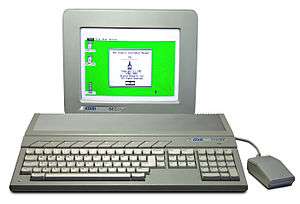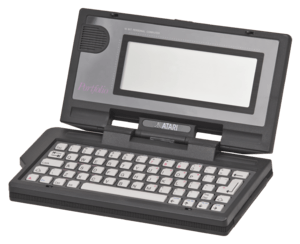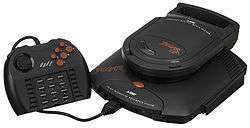Atari Corporation
 | |
| Fate | Closed, properties sold |
|---|---|
| Successor |
JTS Corporation (1996–1998) Atari Interactive (division of Hasbro Interactive) (1998–2001) |
| Founded | July 1, 1984 (as Tramel Technology, Ltd.) |
| Defunct | 1996 |
| Headquarters | United States |
Key people | Jack Tramiel |
| Products |
Atari ST Atari 7800 Atari Portfolio Atari Lynx Atari Jaguar |
| Subsidiaries | Atari Games |
Atari Corporation was an American manufacturer of computers and video game consoles from 1984 to 1996. Atari Corp. was founded in July 1984 when Warner Communications sold the home computing and game console divisions of Atari, Inc. to Jack Tramiel. Its chief products were the Atari ST, Atari XE, Atari 7800, Atari Lynx, and Atari Jaguar. The company reverse merged with JTS Inc. in 1996, becoming a small division, which itself closed when JTS liquidated the IP to Hasbro Interactive in 1998.
History

The company was founded by Commodore International's founder Jack Tramiel soon after his resignation from Commodore in January 1984. Initially named Tramel Technology, Ltd. (TTL), the company's goal was to design and sell a next-generation home computer. On July 1, 1984 TTL bought the Consumer Division assets of Atari, Inc. from its owner Warner Communications, and TTL was renamed Atari Corporation. Warner sold the division for $240 million in stocks under the new company.
Under Tramiel's ownership, Atari Corp. used the remaining stock of game console inventory to keep the company afloat while they finished development of their 16-bit computer system, the Atari ST. In 1985, they released their update to the 8-bit computer line—the Atari XE series—as well as the 16-bit Atari ST line. Then in 1986, Atari Corp. launched two consoles designed under the Warner Atari: Atari 2600 Jr and Atari 7800, which had a limited release in 1984. Atari Corp. rebounded, producing a $25 million profit that year. The Atari ST line proved very successful (but mostly in Europe, not the U.S.), ultimately selling more than 5 million units. Its built-in MIDI ports made it especially popular among musicians. Still, its closest competitor in the marketplace, the Commodore Amiga, outsold it 3 to 2. Atari eventually released a line of inexpensive IBM PC compatibles as well as an MS-DOS compatible palm computer called the Atari Portfolio.
Atari under Tramiel had a poor reputation in the marketplace. In 1986 a columnist for Atari magazine ANALOG Computing warned that company executives seemed to emulate Tramiel's "'penny-pinching' [and] hard-nosed bargaining, sometimes at the risk of everything else", resulting in poor customer service and documentation, and product release dates that were "perhaps not the entire truth ... Pretty soon, you don't believe anything they say". He concluded, "I think Atari Corp. had better start considering how they're perceived by the non-Atari-using public".[1] The company, however, was much more open to the press than its predecessor Atari Inc., which had refused to let Antic preview forthcoming announcements and even opposed the magazine printing the word "Atari" on its issues.[2]
In 1987, Atari acquired Federated Group for $67.3 million to have their own retail store shelf space.[3] Atari quickly discovered that Federated's financial problems were far worse than they had believed. During this time, the FBI investigated Atari for reselling Japanese DRAM chips in the US, "in violation of U.S. import laws and contrary to import agreements".[4] Federated was eventually sold to Silo in 1989.[5]
In 1989, Atari Corp. released the Atari Lynx—a handheld console with color graphics—to critical acclaim. However, a shortage of parts kept the system from being released nationwide for the 1989 Christmas season. The Lynx lost market share to Nintendo's Game Boy, which had only a monochrome display, but a much better battery life, and was widely available. Also in 1989, Atari Corp. lost a $250 million lawsuit alleging that Nintendo had an illegal monopoly.
As the fortunes of Atari Corporation's ST and PC compatible computers faded, consoles and software again became the company's main focus. In 1993, Atari Corp. released its last console: the Atari Jaguar. After a period of initial success, it failed to meet expectations. It was not nearly as powerful as Sony Computer Entertainment's PlayStation or Sega's Saturn and lacked the extensive third party support its Japanese competitors had easily secured for their consoles.
Atari Corp.'s reverse merger with JT Storage Inc.
By 1996, a series of successful lawsuits followed by profitable investments had left Atari with millions of dollars in the bank, but the failure of the Lynx and Jaguar left Atari without any products to sell. In addition, Tramiel and his family wanted out. The result was a rapid succession of changes in ownership. In July 1996, Atari merged with JTS Inc., a short-lived maker of hard disk drives, to form JTS Corp.[6] Atari's role in the new company largely became a holder for the Atari properties and minor support; consequently the name largely disappeared from the market.
In March 1998, JTS sold the Atari name and assets to Hasbro Interactive for $5 million—less than a fifth of what Warner Communications had paid 22 years earlier. This transaction primarily involved the brand and intellectual property, which now fell under the Atari Interactive division of Hasbro Interactive.
List of products


- Atari ST (1985)
- Atari STacy (1989)
- Atari TT030 (1990)
- Atari MEGA STE (1991)
- ST BOOK (1991)
- Atari XE series (1985)
- Atari 7800 (1986)
- Atari 2600 Jr. (1986)
- Atari XEGS (1987)
- Atari Transputer Workstation (1989)
- Atari Portfolio (1989)
- Atari Lynx (1989)
- Atari Panther (Cancelled)
- Atari Falcon (1992)
- Atari Jaguar (1993)
- Atari Jaguar CD (1995)
See also
| Wikimedia Commons has media related to Atari. |
References
- ↑ Leyenberger, Arthur (February 1986). "The End User". ANALOG Computing. pp. 109–110. Retrieved 24 June 2014.
- ↑ Friedland, Nat (March 1987). "Today's Atari Corp. | A close-up look inside". Antic. pp. 30–33. Retrieved 4 July 2014.
- ↑ http://articles.latimes.com/1987-08-24/business/fi-2005_1_atari
- ↑ http://www.atarileaks.org/index.html
- ↑ http://www.nytimes.com/1989/11/11/business/company-news-atari-is-selling-26-federated-stores.html
- ↑ Sample Contracts - Agreement and Plan of Reorganization - Atari Corp. and JT Storage Inc. - Competitive Intelligence for Investors
External links
- The Atari History Museum – Atari historical archive site
- AtariAge.com
- Atari Gaming Headquarters – Atari historical archive site